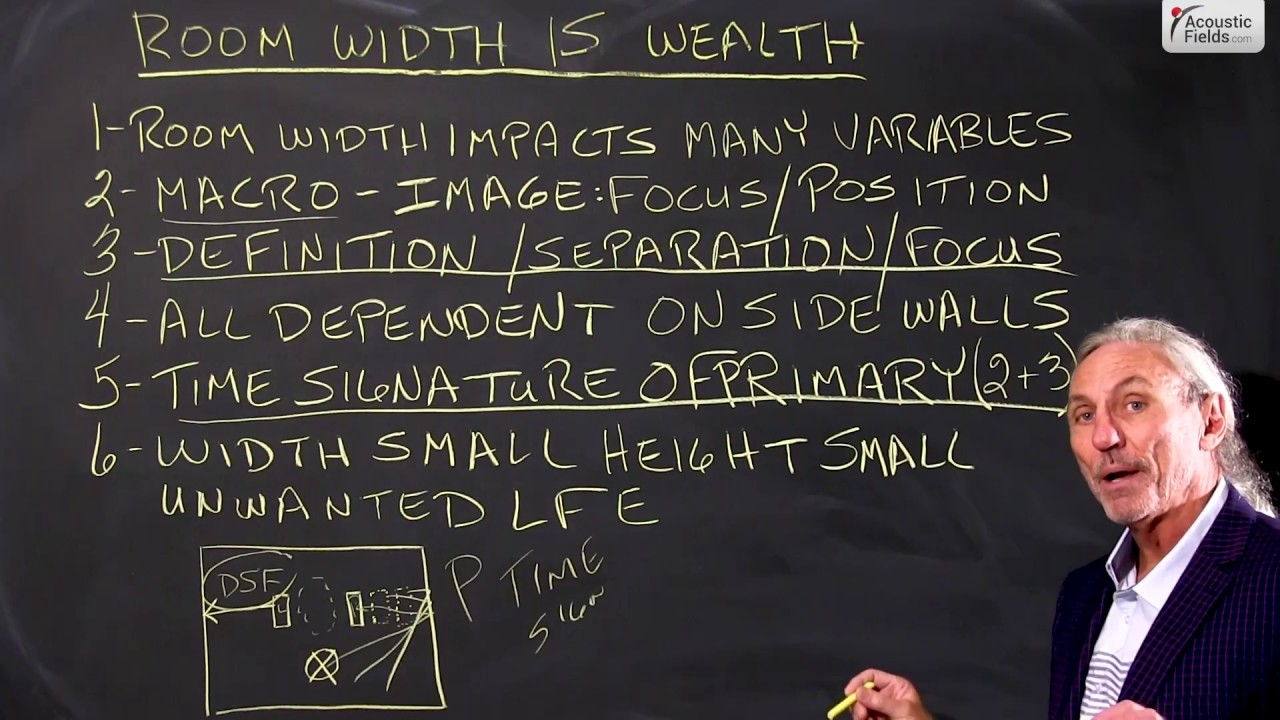Today we’re going to talk about room width as being very wealth, wealthy if you will. I mean it’s a good dimension to have in your favor because boy, in North America at least the rooms that I see every day, it’s that 8-foot ceiling height and you know, that’s one of the worst dimensions in acoustics we could ask for. Thank God, in a lot of cases it’s not the actual height, it’s the drop ceiling height. We have another foot or two above that if we look structurally but a lot of times, not the case, it’s 8 foot.
So where else do we go? Well, we’ve got to get the width and we’ve got to get the length if we don’t have the height. So the room width really impacts a lot of variables that we use for evaluation, especially in 2-channel stereo. So we take a big picture look, if we take a macro level view, it’s image, focus and position and that’s what we’re trying to do with the sidewall implication.
So we want to make sure that we have good definition, we have good separation, we have focus. And that’s all related here: definition, separation, focus for our center channel image is all in this signal here. So we have to be real careful with that and we have to treat it with care.
So time signature, absorption. If we’re going to use absorption and we do most of the time because it gives us the definition, separation and focus that we want in our central channel image and then we add air and more separation with diffusion on other surfaces. But let’s take a look here. If we have our regular speakers, our left and our right channel here, we have one distance for primary in this case but if we take the right channel and we start to move it closer to the room boundary surface we’re going to change one, the angle, we’re going to change the time signature and we’re going to change the distance.
So it’s time, energy, frequency that we’re always concerned about. So as we move closer to the room boundary surface we increase pressure, we change the time signature 01or the reflection and all of this has an impact on our definition, separation and focus. So you have to be real careful.
This was the primary reason I created my foam technology. Because I had tested all the foam technologies in the marketplace back in the 90’s and none of them gave me that kind of definition that I knew 2-channel stereo was capable of producing, not one worked in my opinion as advertised. So what did I do? I created a new curve, a new absorption curve that is more for music and voice. Because they’re special and they have to have special treatments, okay? We perceive music and voice a lot different than we do other things.
So the rate and level of absorption of the absorption material that we use on the sidewalls is critical. So the more width we have in the room, the more flexibility. Obviously if we could get room width way out here, maybe even become an opportunity for no treatment. Because it would be far enough away that we didn’t have to manage it that correctly, other issues would then come into play. And we know that that width-height ratio is really small sometimes in our room so we have to be really careful there because then we add all kinds of low frequency pressure issues into the room.
So room width is wealth if you have to have a dimension that’s one, that’s large, let’s look for the width and especially with our 2-channel systems.
—
This is an unedited transcript from our video series from Acoustic Fields. There will be some errors in grammar and sentence structure that occur during this translation process.
For complete understanding and comprehension, please view the video which is included in this text. For any additional information regarding this topic or others relating to room acoustics, please contact us directly at:
P: 520 – 392 – 9486








HI Dennis , I am an acoustic finger style guitarist and singer . I want to build a shed in my yard for practice and live recording I have to keep it under 200 square feet so I don’t have to get it permitted by the city . It cannot be higher than 14 feet can you give me the ideal size to build this for the best sound ? thanks
O, Our room design services are broken down into two parts: noise and treatment. Each has an associated fee of 1,500 USD. If you require both noise and treatment services, the fee is 2,500.00. A credit of 50% of all design fees will be credited towards technology purchases from Acoustic Fields. Room size/volume/usage is complicated with much to calculate. There is no one size. What is your budget for the project?
TREATMENT
The treatment design includes room size and volume, source (speaker)/listening positions within room size and volume for 2 – 40 channels, all low, middle, and high-frequency absorption management, including proper rates and levels of absorption to match usage, type/amount/position. All middle and high-frequency diffusion specified as to type/amount/position to include proper diffusion frequency response/usage. All DIY drawings are provided for all specified treatments and types. Telephone consultation is available to assist you with any build or product implementation.
NOISE
Noise analysis includes all internal/ external noise frequency and amplitude measurements taken by the client under my assistance. Noise measurements are taken inside and outside of the subject room twice a day over 7 days. Barrier design based on these seven-day noise study showing frequency, amplitude, and SPL. DIY drawings provided for barrier design are based on these measurement numbers. Material list provided to build the specified barrier. Telephone consultation is available to assist you with any build or product implementation.